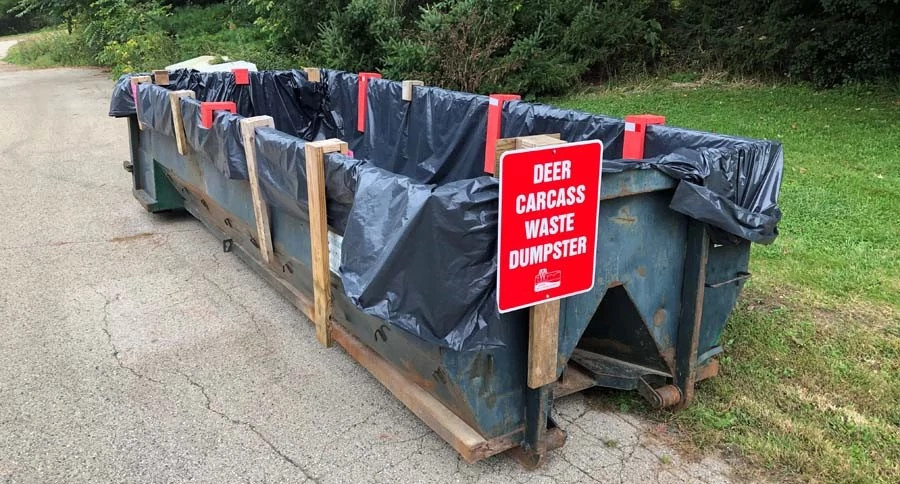Contact: Amanda Kamps, DNR wildlife health conservation specialist
Amanda.Kamps@wisconsin.gov or 608-712-5280
Dan Kroll, DNR waste management specialist
Daniel.Kroll@wisconsin.gov or 920-662-5488
DNR Reminds Hunters About Deer Transportation Regulations And Carcass Disposal Options
 Carcass disposal dumpsters are available around the state this hunting season. Find one near you on the DNR website.
Photo credit: Wisconsin DNR
Carcass disposal dumpsters are available around the state this hunting season. Find one near you on the DNR website.
Photo credit: Wisconsin DNR
MADISON, Wis. – With the 2020 deer hunting season underway, hunters are reminded by the Wisconsin Department of Natural Resources (DNR) to follow the deer carcass transport regulations and to dispose of deer carcass waste appropriately. The movement of deer carcasses infected with chronic wasting disease (CWD) is a pathway for the disease to spread, and leaving carcass parts on the landscape is a possible route for disease transmission to other deer.
CWD can spread among deer by direct contact between animals and indirectly through exposure to environments contaminated with CWD prions, the protein that causes the disease. Exposure to an area where a CWD-positive carcass has decomposed could be enough to cause infection in deer. Because of this risk, it is vital that deer carcasses, including all bones and other deer carcass waste from butchering, are disposed of in a licensed landfill that accepts deer waste or in a dumpster designated for deer carcass waste.
"CWD prions are infectious even after a positive deer dies, so proper handling and disposal of the carcass is very important to slow the spread of the disease," said Amanda Kamps, DNR wildlife health conservation specialist. "Transporting a CWD-positive carcass to areas that are not yet known to have CWD increases the risk of transmission to new areas of the state.”
Proper disposal of deer carcass waste is a factor in containing the spread of CWD. The DNR is committed to providing safe, convenient disposal options to hunters, especially in areas where options are limited or unavailable.
"This year, more deer carcass waste dumpsters are available to hunters across the state," Kamps said. "Some of the dumpsters will become available right before the nine-day gun deer season, so hunters should check the deer carcass disposal map on the DNR website frequently. More locations will be added and available during the nine-day gun deer season thanks to all the individuals and organizations that are participating in our Adopt-a-Dumpster program."
Carcass movement restrictions are in place to limit the spread of the disease. Both whole deer carcasses and certain parts of carcasses from CWD-affected counties can only be moved within CWD-affected counties and an adjacent county unless going directly to a licensed taxidermist or meat processor within 72 hours of registration.
Hunters in non-CWD affected counties can also take this action voluntarily. Visit the DNR website for a list of deer carcass parts that may be transported beyond CWD-affected counties or an adjacent county, as well as more information about carcass transport.
Hunters from out of state should be aware of their state's carcass movement restrictions of deer harvested in Wisconsin before heading home.
Whole carcasses and parts of carcasses other than those listed, from states and provinces where CWD has been detected, are not allowed to be brought into Wisconsin unless taken to a licensed taxidermist or meat processor within 72 hours of entry into Wisconsin.
Hunters are encouraged to dispose of deer carcass waste in a licensed landfill that accepts this waste or in a dumpster designated for deer carcass waste. If a municipality allows deer disposal curbside or at a transfer station, the carcass should be double bagged. A map with the CWD sampling locations and deer carcass disposal locations is on the DNR website as well as in the Hunt Wild app.

